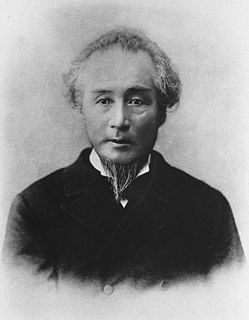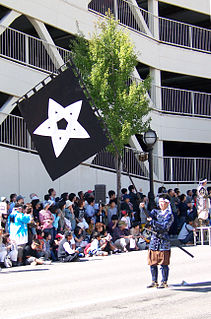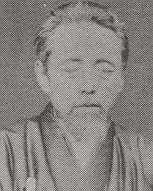 W
WThe Boshin War , sometimes known as the Japanese Revolution, was a civil war in Japan, fought from 1868 to 1869 between forces of the ruling Tokugawa shogunate and those seeking to return political power to the Imperial Court.
 W
WThe Battle of Ueno was a battle of the Boshin War, which occurred on July 4, 1868, between the troops of the Shōgitai under Shibusawa Seiichirō and Amano Hachirō, and Imperial "Kangun" troops.
 W
WBenten Daiba (弁天台場) was a key fortress of the Republic of Ezo in 1868–1869. It was located at the entrance of the bay of Hakodate, in the northern island of Hokkaidō, Japan.
 W
WDate Yoshikuni was a late-Edo period Japanese samurai, and the 13th daimyō of Sendai Domain in the Tōhoku region of northern Japan, the 29th hereditary chieftain of the Date clan. He is known primarily for his role as commander-in-chief of the Ōuetsu Reppan Dōmei during the Boshin War of the Meiji Restoration.
 W
WThe Denshūtai (伝習隊) was a corps of elite troops of the Tokugawa Bakufu during the Bakumatsu period in Japan. The corps was founded by Ōtori Keisuke with the help of the 1867–68 French Military Mission to Japan.
 W
WDupleix was a steam and sail corvette of the French Marine Nationale. She was the first French vessel named after the 18th century governor of Pondichéry and Gouverneur Général of the French possessions in India Marquess Joseph François Dupleix.
 W
WEe ja nai ka (ええじゃないか) was a complex of carnivalesque religious celebrations and communal activities, often understood as social/political protests, which occurred in many parts of Japan from June 1867 to May 1868, at the end of the Edo period and the start of the Meiji Restoration. Particularly intense during the Boshin War, the movement originated in the Kansai region, near Kyoto.
 W
WThe Fall of Edo , also known as Edojō Akewatashi (江戸城明け渡し) and Edo Muketsu Kaijō (江戸無血開城), took place in May and July 1868, when the Japanese capital of Edo, controlled by the Tokugawa shogunate, fell to forces favorable to the restoration of Emperor Meiji during the Boshin War.
 W
WGoryōkaku (五稜郭) is a star fort in the Japanese city of Hakodate on the island of Hokkaido. It was the main fortress of the short-lived Republic of Ezo.
 W
WThe Battle of Hakodate was fought in Japan from December 4, 1868 to June 27, 1869, between the remnants of the Tokugawa shogunate army, consolidated into the armed forces of the rebel Ezo Republic, and the armies of the newly formed Imperial government. It was the last stage of the Boshin War, and occurred around Hakodate in the northern Japanese island of Hokkaidō. In Japanese, it is also known as the Battle of Goryokaku
 W
WThe Battle of Hokuetsu was a battle of the Boshin War of the Meiji Restoration, which occurred in 1868 in the northwestern part of Japan, in the area of modern Niigata Prefecture.
 W
WMarshal Admiral Baron Ijūin Gorō was a Meiji-period career officer in the Imperial Japanese Navy.
 W
WCount Itagaki Taisuke was a Japanese soldier, politician and leader of the Freedom and People's Rights Movement , which evolved into Japan's first political party. His image is on Japan's 1953 100-yen banknote.
 W
WSMS Danzig was a paddle corvette of the Prussian Navy. She is most notable for her role in the Battle of Tres Forcas in 1856. She was later decommissioned from the Prussian Navy and served in the navy of the Japanese Tokugawa shogunate as the Kaiten from 1864 until 1869, and then briefly with the breakaway Ezo Republic until her destruction later the same year.
 W
WCount Katsu Yasuyoshi , best known by his nickname Katsu Kaishū , was a Japanese statesman and naval engineer during the late Tokugawa shogunate and early Meiji period. Kaishū was a nickname which he took from a piece of calligraphy by Sakuma Shōzan. He went through a series of given names throughout his life; his childhood name was Rintarō (麟太郎). He was often called Awa (安房) from his title Awano-kami (安房守) during the late Tokugawa shogunate and later changed his name to Yasuyoshi after the Meiji Restoration.
 W
WKirino Toshiaki was a Japanese samurai of the late Edo period, and an Imperial Japanese Army general of the early Meiji era.
 W
WCount Kuroda Kiyotaka , also known as Kuroda Ryōsuke , was a Japanese politician of the Meiji era. He was Prime Minister of Japan from 1888 to 1889. He was also vice chairman of the Hokkaido Development Commission (Kaitaku-shi).
 W
WEmperor Meiji , also called Meiji the Great , or Meiji the Good , was the 122nd Emperor of Japan according to the traditional order of succession, reigning from 3 February 1867 until his death on 30 July 1912. He presided over the Meiji era, a time of rapid change that witnessed the Empire of Japan's transformation from an isolationist, feudal state to an industrialized world power.
 W
WThe Ōuetsu Reppan Dōmei was a Japanese military-political coalition established and disestablished over the course of several months in early to mid-1868 during the Boshin War. Its flag was either a white interwoven five-pointed star on a black field, or a black interwoven five-pointed star on a white field. It is also known as the Northern Alliance .
 W
WHMS Pearl was a Pearl-class 21-gun screw corvette of the Royal Navy launched in 1855, displacing 2,187 tons.
 W
WThe Republic of Ezo was a short-lived state established in 1869 by a part of the former Tokugawa military on the island of Ezo, now known as Hokkaido. Ezo is notable for being the first government to attempt to institute democracy in Japan, though voting was allowed only to the samurai caste.
 W
WSaigō Takamori (Takanaga) was one of the most influential samurai in Japanese history and one of the three great nobles who led the Meiji Restoration. Living during the late Edo and early Meiji periods, he has been dubbed the last true samurai.
 W
WThe Shaguma was a type of headgear worn by the officers of the Imperial Japanese Army troops in the Boshin War (1868–69). The headgear was quite peculiar, being a sort of wig composed of long, dyed yak hair and held in place by a chin-strap.
 W
WShiba Gorō was a samurai of Aizu Domain and later a career officer and general in the Meiji period Imperial Japanese Army.
 W
WThe Shinsengumi was a special police force organized by the Bakufu during Japan's Bakumatsu period in 1863. It was active until 1869. It was founded to protect the shogunate representatives in Kyoto at a time when a controversial imperial edict to exclude foreign trade from Japan had been made and the Chōshū clan had been forced from the imperial court. The men were drawn from the sword schools of Edo.
 W
WThe Shōgitai was an elite samurai shock infantry formation of the Tokugawa shogunate military formed in 1868 by the hatamoto Amano Hachirō and Hitotsubashi Gosankyō retainer Shibusawa Seiichirō in Zōshigaya, Edo. The Shōgitai took a large part in the battles of the Boshin War, especially at the Battle of Toba–Fushimi, and, after being assigned the defence of Kan'ei-ji temple, the Battle of Ueno, where they were nearly exterminated.
 W
WTakeda Ayasaburō , was a Japanese Rangaku scholar, and the architect of the fortress of Goryōkaku in Hokkaidō.
 W
WViscount Yamaji Motoharu , was a lieutenant general in the early Imperial Japanese Army during the First Sino-Japanese War.
 W
WAdmiral Count Yamamoto Gonbee, also called Gonnohyōe , was an admiral in the Imperial Japanese Navy and twice Prime Minister of Japan from 1913 to 1914 and again from 1923 to 1924.
 W
WYamamoto Kakuma was a Japanese samurai of the late Edo period, who went on to become an educator and politician in the Meiji era.
 W
WNiijima Yae , also known as Yamamoto Yaeko , was a Japanese female warrior, nurse and scholar of the late Edo period who lived into the early Shōwa period. Skilled in gunnery, she helped defend Aizu during the Boshin War, earning her the nickname of the “Bakumatsu Joan of Arc”. Yaeko served as a nurse during the Russo-Japanese War and Sino-Japanese War, and became the first woman outside of Imperial House of Japan after the Meiji Restoration to be decorated for her service to the country.
 W
WYamauchi Toyoshige , also known as Yamauchi Yōdō , was a Japanese daimyō in the Shikoku region in the late Edo period. He was usually referred to as “Lord Yōdō” in Western accounts.